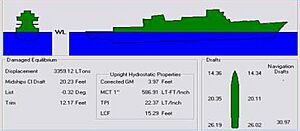Displacement (ship) facts for kids
Have you ever wondered how heavy a ship is? The displacement of a ship is simply its total weight. It's measured by figuring out how much water the ship pushes aside, or "displaces." This idea comes from Archimedes' principle, a famous scientific rule.
When a ship floats, it pushes away a certain amount of water. The weight of this pushed-away water is exactly the same as the ship's total weight. This is how engineers can calculate how heavy a ship is without putting it on a giant scale!
A ship's displacement changes depending on how much stuff it's carrying. It can be its empty weight or its maximum weight when fully loaded. People often measure displacement in tonnes. It's important not to confuse displacement with other measurements like net tonnage or gross tonnage, which are about a ship's internal space or capacity.
Contents
How Is Ship Displacement Calculated?
To find a ship's displacement, the first step is to measure its draft. The draft is how deep the ship sits in the water. Ships have special "draft marks" painted on their sides, like a giant ruler. There are marks at the front, middle, and back on both sides of the ship.
Workers read these marks to find the average depth the ship is floating at. Then, they use special tables, called hydrostatic tables, to find the volume of water the ship is displacing.
To get the weight of this water, they need to know its density. For example, seawater is heavier than fresh water. This is why a ship floats higher in the ocean than in a river. The temperature of the water also affects its density.
In the past, people used special tools like slide rules for these calculations. Today, computers do all the hard work quickly and accurately. Displacement is usually measured in tonnes.
Different Kinds of Ship Displacement
There are different terms for a ship's displacement, depending on what it's carrying:
Loaded Displacement
- Loaded displacement is the total weight of the ship when it's ready for a trip. This includes the ship itself, plus all its cargo, passengers, fuel, fresh water, and supplies. This is when the ship sits lowest in the water, at its "load draft."
- Full load displacement is very similar. It's the maximum weight a ship is allowed to carry, as approved by safety rules. Warships also have a full load condition, but it's set during their design.
Light Displacement
- Light displacement (LDT) is the weight of the ship when it's empty. This means it has no cargo, fuel, passengers, or crew. It's just the ship itself, with water in its boilers if it's a steamship.
Standard Displacement
- Standard displacement is a special term mainly used for warships. It was defined by an agreement called the Washington Naval Treaty in 1922. This measurement includes the ship, its crew, engines, weapons, and ammunition. However, it does NOT include fuel or extra boiler water. It's basically the weight of a warship ready for battle, but without its fuel.
Images for kids
-
Greek philosopher Archimedes having his famous bath, the birth of the theory of displacement
-
A ship's hydrostatic curves. Lines 4 and 5 are used to convert from mean draft in meters to displacement in tonnes (table in Spanish).
See also
 In Spanish: Desplazamiento (náutica) para niños
In Spanish: Desplazamiento (náutica) para niños
- Naval architecture
- Hull (watercraft)
- Hydrodynamics
- Tonnage






